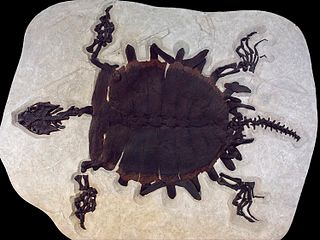
The Anthicidae are a family of beetles that resemble ants. They are sometimes called ant-like flower beetles or ant-like beetles. The family comprises over 3,500 species in about 100 genera.

Condylura is a genus of moles that contains a single extant species, the star-nosed mole (Condylura cristata) endemic to the northern parts of North America. It is also the only living member of the tribe Condylurini.
The Chitarwata Formation is a geological formation in western Pakistan, made up of Oligocene and early Miocene terrestrial fluvial facies. The sediments were deposited in coastal depositional environments when Pakistan was partly covered by the Tethys Ocean.

The Gray Fossil Site is an Early Pliocene assemblage of fossils dating between 4.5 and 4.9 million years old, located near the community of Gray in Washington County, Tennessee. The site was discovered during road construction on Tennessee State Route 75 by the Tennessee Department of Transportation in May 2000, after which local officials decided to preserve the site for research and education. The site became part of East Tennessee State University, and the Gray Fossil Site & Museum was opened on the site in 2007.

Microcoelus is a dubious genus of small titanosaurian sauropod dinosaur from the Bajo de la Carpa Formation, Argentina. It is known from only a single dorsal vertebra. A left humerus was formerly referred to this species, but it is now considered to belong to Neuquensaurus. This species is considered a nomen dubium.

Axestemys is an extinct genus of softshell turtle that lived from the Late Cretaceous to the Eocene in western North America and Europe.

The Complete Guide to Prehistoric Life is a 2005 encyclopedia featuring 111 of the prehistoric animals from the Walking with... series, as well as an additional one. It was published in 2005 by Firefly Books, and written by Tim Haines with Paul Chambers. It accompanies all of the main programs in the Walking with... series, including specials The Ballad of Big Al, The Giant Claw and Land of Giants but excluding Walking with Cavemen.
Paleontology or palaeontology is the study of prehistoric life forms on Earth through the examination of plant and animal fossils. This includes the study of body fossils, tracks (ichnites), burrows, cast-off parts, fossilised feces (coprolites), palynomorphs and chemical residues. Because humans have encountered fossils for millennia, paleontology has a long history both before and after becoming formalized as a science. This article records significant discoveries and events related to paleontology that occurred or were published in the year 1888.

The Scalopinae, or New World moles, are one of three subfamilies of the family Talpidae, which consists of moles and mole-like animals; the other two subfamilies being the Old World talpids and the Chinese shrew-like moles (Uropsilinae). The Scalopinae are the only Talpidae subfamily to consist entirely of undisputed moles and no mole-like close relatives such as shrew-moles or desmans.

Macrosemiidae is an extinct family of ginglymodian fish. The family first appeared during the Middle Triassic and disappeared during the Late Cretaceous. The group has been found in rock formations in Africa, Australia, Eurasia and North America. As ginglymodians, their closest living relatives are gars, with them being typically placed as nested within the Semionotiformes. Many members of the family have elongated dorsal fins, often associated with adjacent area of skin which was free of scales. These fins were likely undulated for use in precision swimming. Their body morphology suggests that they were slow swimmers that were capable of maneuvering around complex topography, such as reef environments.

Dillhoffia is an extinct monotypic genus of flowering plant with a single species, Dillhoffia cachensis known from Ypresian age Eocene fossils found in British Columbia, Canada, and Washington, US. The genus and species were described from fifteen specimens found in an unnamed formation belonging to the Kamloops group shales; and two specimens from the Klondike Mountain Formation. The unnamed formation outcrops at the McAbee Fossil Beds near Cache Creek, BC, which is designated the type locality while the two U.S. specimens were recovered from the Tom Thumb Tuff member of the Klondike Mountain Formation in Republic, Washington. Of the Okanagan highlands fossil sites, Dillhoffia is only known from two locations, and is absent or has not been identified from the others.

Pseudogarypus synchrotron is an extinct species of pseudoscorpion in the family Pseudogarypidae known from only two Eocene fossils found in Europe. P. synchrotron is one of four species in the genus Pseudogarypus to have been described from fossils.
Ustatochoerus is an extinct genus of oreodont of the family Merycoidodontidae, endemic to North America. It lived during the late Oligocene to Miocene, 24–10.3 mya, existing for approximately 14 mya. Fossils are widespread through the central and western United States.

Adcrocuta is an extinct genus of terrestrial carnivore in the family Hyaenidae that lived in Africa and Eurasia during the Miocene epoch.
The Coffee Sand is a geologic formation in Tennessee. It preserves fossils dating back to the Cretaceous period. It preserved indeterminate hadrosauroids including a possible adult Eotrachodon.

Otekaikea is an extinct genus of toothed whale closely related to Waipatia. It is known from the late Oligocene (Chattian) of New Zealand.

Otocephala is a clade of ray-finned fishes within the infraclass Teleostei that evolved some 230 million years ago. It is named for the presence of a hearing (otophysic) link from the swimbladder to the inner ear. Other names proposed for the group include Ostarioclupeomorpha and Otomorpha.
Ganawamaya is an extinct genus of quadrupedal kangaroos that lived in Australia. Its fossils have been found in various Oligocene and Miocene deposits throughout South Australia and Queensland. Four species are currently recognised, G. acris , G. aediculis, G. gillespieae, and G. couperi.
Palaeontologia Electronica is a triannual peer-reviewed open-access scientific journal published by Coquina Press covering paleontology. It was established in 1998 and is the oldest fully open-access electronic journal of paleontology. The journal is sponsored by the Society of Vertebrate Paleontology, the Paleontological Society, the Palaeontological Association, and the Western Interior Paleontological Society. The editors-in-chief are Julien Louys and Andrew Bush. In 2000, the first taxonomic names published electronically under new rules in the International Code of Zoological Nomenclature were published in the journal by Scott et al. for three new species of fossil foraminifera: Eggerella matsunoi, Haplophragmoides hatai, and Haplophragmoides nishikizawensis.

Luchibang is an extinct genus of istiodactylid pterosaur discovered in Inner Mongolia, China. The type and only species is Luchibang xingzhe. The genus was initially established on the basis of a supposed nearly complete skeleton and skull, although later analysis of the specimen revealed that it represents a chimera, with the Luchibang holotype restricted to the end of the snout.













